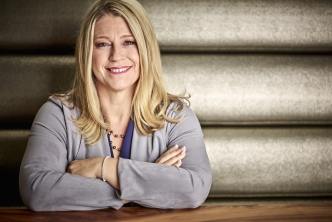
In conversation with Thrive and SVCN
We sat down with Georgia D. Farooq, Executive Director of Thrive Alliance of Nonprofits for San Mateo County (Thrive), and Kyra Kazantzis, CEO of the Silicon Valley Council of Nonprofits, to talk about how local nonprofits weathered the past two years, lessons learned, and their hopes for the future.
Tell us a bit about what your organizations do, and how you collaborate.
Georgia D. Farooq: Thrive is a network of 200+ nonprofit organizations, government entities, foundations, businesses, and community leaders committed to improving the quality of life in San Mateo County. We work to unite the voice and influence of nonprofits in San Mateo County, help build their capacity, and enable effective cross-sector collaboration. Thrive has always leaned toward radical collaboration with a broad, diverse range of partners, which has increased our agility and impact during this unprecedented time.
Kyra Kazantzis: Silicon Valley Council of Nonprofits (SVCN) unifies and strengthens the voice of local community-serving nonprofits in Santa Clara County so they can become more effective advocates for their organizations and communities. SVCN’s training program focuses on organizational effectiveness and capacity-building. Our policy team advocates at the city, county, and state level on behalf of nonprofits on policies that affect the sector; we also team with our nonprofit community on issues it identifies as critical to creating equitable and thriving communities and furthering racial justice. SVCN’s nonprofit membership is 170+ strong; we also offer Ally Membership to individuals, businesses, and foundations.
To support the nonprofit community, we work closely with Thrive as well as with other nonprofit associations like the Center for Excellence in Nonprofits (CEN), based in Redwood City, as well as the Behavioral Health Contractors Association, Community Health Partnership, and numerous nonprofit coalitions and cohorts.
Thrive and SVCN have been at the forefront of supporting and advocating for local nonprofits during the pandemic and converging crises. What are your key takeaways from this time?
Georgia: Collaboration has been the shining star of this whole pandemic. It’s been incredible to see how people have worked together and formed new organic alliances. A great example is how closely the County and nonprofits collaborated on vaccine rollout efforts, and another is how youth & education nonprofits leaned on each other very quickly to set up learning hubs during shelter in place. People were able to tap into channels that we, as a sector, had invested in building out for Census and prior emergencies. San Mateo County is legendary in terms of how collaborative it is, but I think the power of that collaboration became very visible, and having that muscle was a tremendous asset during this time to support local communities.
Kyra: Another bright spot we saw on the funder side was the way so many foundations moved to more flexible grantmaking practices, which was hugely helpful. This has been something we’d been advocating for for a long time, and seeing so many funders embrace more trust-based philanthropy was really heartening. The ability it provided nonprofits to shift efforts and resources where they were most needed was a testament to the groundwork many of us had laid, and hopefully one of the lessons in terms of best practice we will sustain as we move into this recovery phase.
What are some of the biggest challenges for nonprofits today, and how can donors help?
Georgia: We surveyed our members this year, and while Silicon Valley nonprofits fared better than national averages, local nonprofits still saw an 8% decrease in financial health from pre-pandemic to post-pandemic. We’ve also seen some sub-sectors do better than others because they were at the forefront of delivering emergency services, while arts and culture or education, for example, have been hit harder - arts & culture nonprofits saw a 23% drop in financial health, for example. So directing funds to areas that might have seen a more significant drop in donations will be key to helping those nonprofits get back on their feet.
Sustaining the workforce is also a huge challenge for nonprofits today. Nonprofit leaders have been working nonstop since the beginning of the pandemic— we hear about a lot of burn out. Compensation levels are also just not sufficient to enable the nonprofit workforce to live and thrive in the Bay Area. This was already an issue pre-pandemic, but as many took time to reflect over the past 18 months and realized they could thrive elsewhere, we’re seeing more and more people move away. Obviously not everyone can afford to leave a job, but for those who have a choice, it’s led some to realize there is a different way of being. There needs to be creativity around supporting nonprofits overall, advocating for better compensation, investing in hiring, recruitment, retention as well as mental health, if we want this sector to survive in the Bay Area. These are all areas where private philanthropy can play a huge role.
Kyra Kazantzis: Absolutely. Hiring is a huge challenge for nonprofits right now. In the mental health space, for example, which has been identified nationwide and locally as a high-priority area of investment for pandemic recovery, nonprofits just can’t find enough people to deliver services. It’s very hard for nonprofits to compete with the private sector and even the County. At SVCN, we’re advocating for additional public funding to improve salaries. Overall, the nonprofit needs to make the case to private philanthropy that compensation—and breaking the nonprofit starvation cycle—is a key area of investment if the nonprofit sector is to be more effective in supporting local communities and moving the needle on the root causes of poverty, including systemic racism. There needs to be an honest conversation between nonprofits and institutional funders about what it will take to move the needle on these issues, including resources, but that is what is needed to get to transformative impact.
In addition to the phenomenal collaboration and coordination among nonprofits, oftentimes with local governments, we saw some really great examples during COVID of nonprofits providing resources to others. For example, one organization loaned staff to another nonprofit to process emergency cash assistance applications to prevent an eviction tsunami. Both Thrive and SVCN are working on capitalizing this mutual synergy by facilitating nonprofit strategic partnership and mutual assistance.
Racial equity has been very central for many of us. Both your organizations are on your own racial equity journeys. How are you supporting your members on this?
Kyra Kazantzis: This year, after a rich and long collaborative process, SVCN launched the Nonprofit Racial Equity Pledge. The pledge is a commitment to center racial justice and equity and actively center community voices within nonprofit organizations at all levels. It’s also a commitment of local nonprofits to use their positional power to collectively support movements to transform systems that perpetuate racial inequities, and advance community power-building. Over 150 organizations have signed the pledge and nearly 80 organizations have joined the Race Equity Action Leadership coalition that SVCN co-facilitates. Because nonprofit leadership and Board members have started in different places and are moving at different paces on racial justice, equity, diversity and inclusion, SVCN is working with Thrive, CEN, and others to develop curriculum, materials, and other support mechanisms to aid organizations and leaders on this journey. There is much to be done.
Georgia D. Farooq: At Thrive, we’ve been working closely with San Mateo County on budget hearings and strategic alliances, and advocating for more investments in the nonprofit sector, in particular on racial equity and social justice work led by nonprofits. We’ve also been working closely with the County's new Chief Equity Officer to exchange ideas about advancing equity, and how to bring nonprofit leaders to work together on advancing this vision. And we're thrilled to partner with SVCN and CEN on providing more capacity building in this area. We’ve each been offering DEI trainings for years, but the work has been fragmented, and we are excited to see these issues be more centered for many of our members. Our next stop is anti-bias trainings for San Mateo County nonprofit boards so they are better equipped to support BIPOC leaders and the communities they serve.
So… how did Silicon Valley donors pass the “Covid” test in your opinion: Did new donors step up? Did existing ones do enough? What gave you hope, or still keeps you up at night?
Georgia D. Farooq: This experience really showed me how important community foundations were in times of crisis, and the incredibly important role they play to support nonprofits in emergency situations when they don’t have the capacity to accelerate their fundraising as needs increase. We also saw an interesting shift in how foundations perceived their “local portfolios” and a bigger appetite to support a broader ecosystem of nonprofit players, beyond their usual grantees, which is something I’m hopeful will continue. Nonprofits also really found their voice during this time, and became more involved in advocating for the resources they and their communities really needed. So I’m hopeful this momentum and confidence will continue to grow, and that the sector will continue to develop this ability to amplify its vision and work.
Kyra Kazantzis: One place where donors definitely showed up was for the food community, where we saw donations and government funding increase; this was both a blessing and very hard-fought, given that the food need dramatically increased. The response of numerous foundations to pump out COVID relief money, mostly in operating grants, was also really heartening and made a huge difference, enabling nonprofits to redirect resources to the work on the ground. For me, a question mark remains as to whether the corporate community—which showed up fairly strongly in the initial phases of the pandemic—will continue to support throughout the recovery and beyond. Of course, relying on the fluctuating interest of corporations to tackle big challenges like root causes of poverty and systemic racism is no substitute for meaningful corporate tax reform. As we move into this recovery phase, I fear that people will forget about the ongoing pandemic needs and the deep inequities that we all witnessed and move on. This window of opportunity may already be closing, which makes me feel like we should be working 24/7 before that happens.

